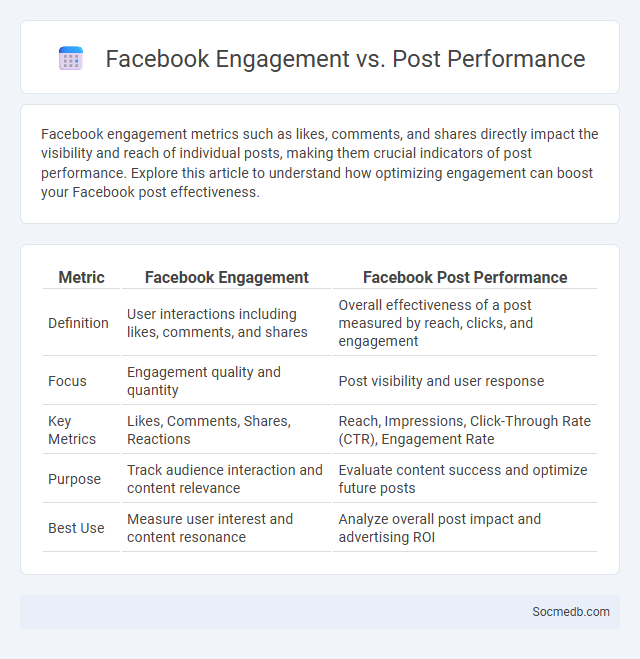
Photo illustration: Facebook Engagement vs Post Performance
Facebook engagement metrics such as likes, comments, and shares directly impact the visibility and reach of individual posts, making them crucial indicators of post performance. Explore this article to understand how optimizing engagement can boost your Facebook post effectiveness.
Table of Comparison
| Metric | Facebook Engagement | Facebook Post Performance |
|---|---|---|
| Definition | User interactions including likes, comments, and shares | Overall effectiveness of a post measured by reach, clicks, and engagement |
| Focus | Engagement quality and quantity | Post visibility and user response |
| Key Metrics | Likes, Comments, Shares, Reactions | Reach, Impressions, Click-Through Rate (CTR), Engagement Rate |
| Purpose | Track audience interaction and content relevance | Evaluate content success and optimize future posts |
| Best Use | Measure user interest and content resonance | Analyze overall post impact and advertising ROI |
Understanding Facebook Engagement: Definition and Importance
Facebook engagement refers to the interactions users have with content, including likes, comments, shares, and reactions, which directly impact a post's visibility in the News Feed. Higher engagement signals Facebook's algorithm to prioritize content, increasing organic reach and fostering community growth. Understanding engagement metrics is crucial for businesses and creators to optimize content strategies and measure audience interest effectively.
What Is Post Performance on Facebook?
Post performance on Facebook refers to the metrics and engagement levels that indicate how well your content resonates with your audience. Key indicators include likes, shares, comments, reach, and click-through rates, which provide valuable insights into user interaction and content effectiveness. Understanding post performance helps you optimize future posts to increase visibility and engagement on the platform.
Key Metrics for Measuring Engagement
Key metrics for measuring engagement on social media include likes, shares, comments, and click-through rates, which provide insights into audience interaction and content relevance. Tracking follower growth and post reach helps determine the overall visibility and potential impact of your social media presence. Monitoring these metrics regularly allows you to optimize your content strategy and maximize audience engagement effectively.
Differences Between Engagement and Post Performance
Engagement measures user interaction with social media content, including likes, comments, shares, and clicks, reflecting the audience's active participation. Post performance evaluates the overall effectiveness of a post by analyzing reach, impressions, and engagement metrics to determine content impact. Understanding the difference helps marketers optimize content strategy by balancing reach and audience interaction.
How Facebook Calculates Engagement Rates
Facebook calculates engagement rates by dividing the total interactions--such as likes, comments, shares, and clicks--by the total number of impressions or reach, then multiplying by 100 to express it as a percentage. Engagement metrics focus on user actions that indicate interest and interaction with your content, making this rate a key indicator of content effectiveness and audience connection. Understanding how Facebook measures engagement helps you optimize posts to boost visibility and foster stronger community interaction.
Factors Affecting Post Performance
Post performance on social media is significantly influenced by content relevance, timing of the post, and audience engagement metrics such as likes, shares, and comments. Algorithmic preferences prioritize content that generates quick interactions and aligns with user interests, increasing visibility. High-quality visuals, clear calls to action, and consistency in posting schedules also enhance reach and engagement rates.
Engagement vs Post Performance: Which Matters More?
Engagement metrics such as likes, comments, shares, and saves provide deeper insights into audience interaction and content resonance, often indicating long-term brand loyalty. Post performance, measured by reach and impressions, highlights the immediate visibility but may not fully capture user interest or conversion potential. Prioritizing engagement over simple post reach drives more meaningful connections and sustained social media growth for brands and influencers.
Strategies to Boost Facebook Engagement
Strategies to boost Facebook engagement include creating compelling, shareable content tailored to your audience's interests and utilizing Facebook's native features like polls, live videos, and stories to encourage interaction. Consistently analyzing your page insights helps identify the best posting times and content types, allowing you to optimize your strategy for maximum reach and engagement. Engaging directly with your community by responding to comments and messages fosters loyalty and increases the likelihood that Your followers will actively participate in conversations.
Tools for Analyzing Engagement and Post Performance
Social media platforms offer advanced tools such as Facebook Insights, Twitter Analytics, and Instagram Insights to track engagement metrics like likes, shares, comments, and follower growth. These analytics tools enable marketers to evaluate post performance by analyzing reach, impressions, and audience demographics, optimizing content strategy for better ROI. Third-party tools like Hootsuite, Sprout Social, and Buffer provide comprehensive dashboards for comparative analysis across multiple social networks, enhancing data-driven decision making.
Best Practices for Maximizing Both Engagement and Post Performance
Maximizing engagement and post performance on social media requires consistent use of high-quality, relevant content tailored to the target audience's preferences. Utilizing data-driven strategies such as optimal posting times, interactive elements like polls and questions, and leveraging platform-specific features boosts visibility and user interaction. Regular analysis of metrics including reach, impressions, and click-through rates allows for continuous optimization and improved ROI in social media campaigns.
 socmedb.com
socmedb.com